
Sicily is a big island, the largest in the Mediterranean and forty-fifth in the world, so even though we rode over one hundred and fifty miles on our bike tour, we needed to focus on one region.
We couldn’t have picked a better one than Val di Noto.


When we saw the name on our itinerary we envisioned a valley, but the word val in this use dates back to the ancient form of Arabic spoken on Sicily and Malta a thousand years ago.
Val means province, and Noto is one of the three traditional divisions on the island, taking its name from the city of Noto.
These regions, and the islands triangular shape, are represented by the Trinacria that has become the symbol of Sicily.
The odd three-legged figure featuring the head of Medusa and three stalks of wheat is on the flag, coat of arms, street signs – you name it.
We ran into her almost everywhere we went as we pedaled across the island.
The City of Noto


Under the Greeks the city was known as Netum and, according to legend, Daedalus rested here after his flight over the Ionian Sea and Hercules after his seventh task.
In 866, the Arabs took control of Sicily and chose Noto as the capital of one of the three districts of the island.
A massive earthquake in 1693 destroyed the ancient city of Noto, so what we visited was a new version built about five miles away from the original.
In an effort to recreate the grandeur of the ancient city, in the mid-nineteenth century massive structures were constructed along a central thoroughfare, Corso Vittorio Emanuel, in what came to be known as the Sicilian Baroque style.

We entered the heart of the city through the monumental 19th-century arch, Porta Reale, and slowly worked our way along the broad boulevard to the Cathedral of Saint Nicholas of Myra.
The idea was to create a city worthy of the name, and we would have to say that they were quite successful.
We got a feeling almost like walking on the mall in Washington, DC, even if it was on a much smaller scale, because the major landmarks seem so well planned and laid out along the main road.


The Cathedral of Saint Nicholas of Myra is an impressive example of the rebuilding, and has suffered damage from several more earthquakes since being completed in 1776.
We also felt that the Palazzo Ducezio or Town Hall captured the importance of a capital city.

While we walked we couldn’t help but feel as though something was different about Noto. Then it hit us, unlike most Italian cities, Noto has a continuity to it, since almost everything was built at nearly the same time, using the same stone.
Ragusa Ilba

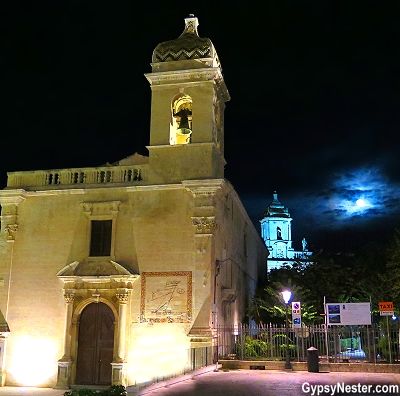
Another city devastated by the earthquake and subsequently rebuilt is Ragusa, or more precisely in our case, Ragusa Ibla.
This older part of the city remains on the original site, while the post-quake newer area is known as Ragusa Superiore, or Upper Ragusa.
We visited Ibla for an evening architectural walking tour and, as luck would have it, found the thickening darkness to be a plus as the buildings lit up against the full-mooned night sky.
Our guide, Lea, met us in the town garden…
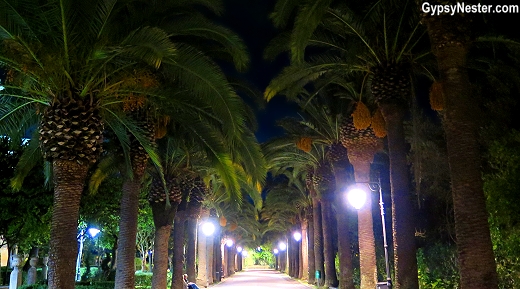
… then led us up the Corso XXV Aprile while explaining how the baroque city was reconstructed.


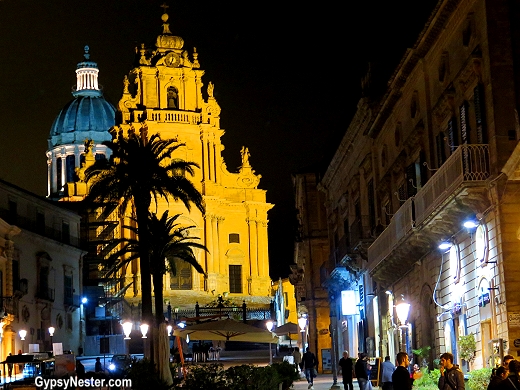

Dominating the village is the Duomo di San Giorgio, designed by architect Rosario Gagliardi.
The cathedral was built from 1739–1775 to replace the original that had only one doorway left after the disaster.
Most impressive, especially at night while bathed in blue light, was the large neoclassical dome that was added in 1820.
Leaving Lea, we wondered on our own – getting purposefully lost in the narrow back streets of intricate, multi-layered Ragusa Ilba.


Modica
Before Ragusa was rebuilt and became the provincial capital, Modica held that position.


The city is truly ancient, going back over three thousand years, and while it was stuck by the earthquake, it was not completely destroyed.
The blend of old and new has earned the city the honor of being recognized as a UNESCO World Heritage Site.
The buildings packed in on the hillside made for an amazing sight, but without a doubt our favorite thing about Modica, was a tour of Sicily’s oldest chocolate maker, Antica Dolceria Bonajuto.

The family has been processing cocoa beans for six generations, since 1880.
But their secrets go back even farther, as they use the methods of the Aztecs brought to Sicily via Spain in the 16th century.
Luckily we sampled the finished product before entering the kitchen; otherwise it might have been impossible to keep our hands out of the cookie jar so to speak.
The rustic chocolate that we sampled and watched being made was a fantastic taste treat and the perfect reward at the end of our morning ride through the surrounding hills.
Watch: Uh, yum. A chocoholic’s paradise

Modica is also dear to our hearts for introducing us to our first Sicilian plate – a yummy array of bread, cheese, meat and veggies.
See more about eating in Sicily – it’s quite the wonderful experience
Thank goodness we were on our trusty steeds, we had to burn off the calories somehow!
Scicli
Perhaps our favorite of the cities we visited in Val di Noto was also the smallest, Scicli.

The city was founded by the Sicels, who gave the town and the island their names, all the way back around 300 BC. We had our share of trouble with the name ourselves, but finally mastered it as pronounced SHE-KLEE.


We rode into town down a steep winding road, stopping before we reached the bottom of the valley at the mountainside Cimitero Comunale, the cemetery of Scicli.
Unlike our typical notion of a graveyard, this is more like a small city built on a hillside.


The rows of mausoleums are arraigned in a grid along narrow street-like paths that stair-step down the slope.
Some are very plain, sort of the high-rise apartments of the cemetery.
Others are extremely ornate and command places of honor and attention, often at an intersection of two of the “roads” – for your guilded palace-types.
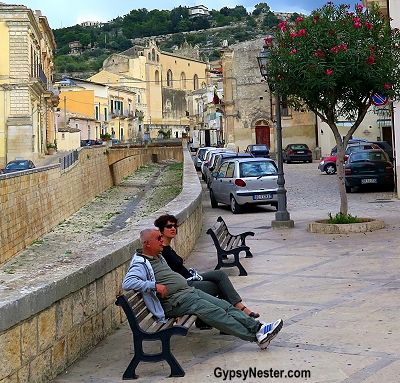
After meandering all the way to the bottom, we climbed back up and remounted our cycles to head into the main part of town.
Scicli was settled where the San Bartolomeo, the Santa Maria La Nuova, and the Fiumara di Modica rivers join; now many of the streets and plazas are actually built over the waterways.
Ducts run throughout.


We followed via Alearde alongside and on top of the Santa Maria La Nuova to Piazza Busacca.
The square honors the city’s biggest benefactor, Pietro Di Lorenzo Busacca – in all his pantalooned-and caped finery, thumb tucked jauntily into his belt — who left the city tons of money back in the fifteen hundreds.
Quite the snazzy dresser, David wanted to ask him for tips.
His statue stands in the center of the square between the family palace, Palazzo Di Lorenzo, and the Church and Covent of Carmine.
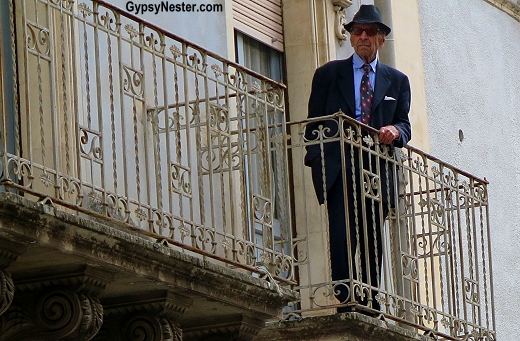

This was not the main square, for that we rode up via Nazionale to Piazza Italia, but from there our attention was focused upward.
Scicli’s foremost attraction, the Church of San Matteo, overlooks the piazza from the top of the hill with the same name.
Even though it is no longer open, it is the oldest church in the city, with the foundations dating back well over a thousand years.
Looking closer, we could see the openings of caves dotting the hillside below.
Known as Chiafura, these were originally used as a cemetery, but became living quarters as people sought the safety of higher ground in the Middle Ages.
Oddly, there were still occupants inhabiting the cave houses until about fifty years ago.
But then, who are we to talk? We’ve been living in a twenty-two foot rolling house for nearly eight years now.
David & Veronica, GypsyNester.com
DELVE DEEPER:
How did we hang on our bicycle tour? See it from the beginning!
We discovered the secrets of Syracuse!
Check out stunning Taormina
Mmmm… the food in Sicily
See all of our adventures in Italy
A big thank you to VBT Bicycling and Walking Vacations for providing this going-for-Baroque adventure! As always, all opinions are our own.
YOUR TURN: Are you ready to go for Baroque in Sicily?




I like your website, I will most certainly return.
nice post thanks for sharing
Thanks!
This is the one of the best article. thanks for sharing such a wonderful post.
Good advice. Thanks for sharing.
First of all excellent photos. Shared a detailed information. One day I will plan for a trip and I would like to taste that chocolate too.
Thanks Such Nice article and useful to everyone
Wow! The views of Sicily’s look amazing! Would love to visit someday!
Such helpful advice! I definitely want to explore Sicily one day.
nice post thanks for sharing this
Sicily is just such a romantic place! Will definitely make a visit.
Such helpful advice! I definitely want to explore Sicily one day.
Such a grand place to wander and I’m Noto kidding. Your night pictures are so alluringly dramatic. It looks like a set from a historic Italian movie. One day I’ll walk in your footsteps, hopefully.
Thanks Elaine! They do have a flair for lighting the buildings, hope you get to go someday soon.
This sounds like a wonderful way to travel— close to the ground although reading your description of descending into a valley makes me wonder about how it was to cycle back up. Your photos and narrative make Sicily seem like somewhere my inner history geek would love to visit—-all those layers.
Luckily we didn’t have to ride back up the hill. We took a van back to the hotel. The trip was mostly set up that way so there were no big climbs. Very nice.
I’m in total agreement with Noel’s comment. Now that I’ve read your post, Sicily is at the top of my wish list too! Your photos offer so many glorious glimpses of this fascinating island and its intriguing history. And I loved the symbol of the Trinacria.
Trinacria intrigued us everywhere we went.
Yes, I’m ready to return to Sicily to see it in a whole new way. Our first visit was on our own, fairly quick, and focused on ruins. Next time: BIKES. FOOD.
Great Kristen! It sure was a good way to see things.
I’ve wanted to visit Ragusa Ibla for the longest time, and add to that cycling and chocolate…and so many other marvelous destinations. Clearly, it’s time to return to Sicily for a closer look!
By bike this time, I hope. It was a great way to go.
I didn’t know that Sicily is ,the largest in the Mediterranean and forty-fifth in the world. Exploring it’s Baroque Cities and architecture would be fascinating and your pics are super:)
Thanks Jo, there is still a lot more of it for us to see.
Sicily is all kinds of crazy good. Chocolate and beef? That’s a new one on me. I’d have to try it.
Don’t see it taking off as a new taste sensation.
Gorgeous photos! Love the Porta Reale area especially. As for chocolate and beef…..I guess I’ll have to try it before I judge, right? I’ve heard Sicily is a great place to visit and these baroque cities definitely confirm this.
Thanks Janice. The chocolate – beef combo is not our new favorite, but it was not terrible either.
Sicily is on the top on my wish list, I really want to visit these wonderful cities and of course eat some of those delicious foods from the island.
Biking was a great way to see it too, and made the eating guilt free.
I’ve been to Sicily but I didn’t get to any of the towns you’ve mentioned. Thanks for this introduction to some lesser known towns.
Glad to shed some light on them Karen.